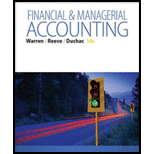
Financial & Managerial Accounting
13th Edition
ISBN: 9781285866307
Author: Carl Warren, James M. Reeve, Jonathan Duchac
Publisher: Cengage Learning
expand_more
expand_more
format_list_bulleted
Concept explainers
Textbook Question
Chapter 22, Problem 22.13EX
Direct labor variances for a service company
Hit-n-Run Food Trucks, Inc. owns and operates food trucks (mobile kitchens) throughout the west coast. The company's employees have varying wage levels depending on their experience and length of time with the company. Employees work 8-hour shifts and are assigned to a truck each day based on labor needs to support the daily menu. One of its trucks, Jose O’Brien's Mobile Fiesta, specializes in Irish-Mexican fusion cuisine. The truck offers a single menu item that changes daily. On November 11, the truck prepared 200 of its most popular item, the Irish breakfast Enchilada, the following data are available for that day:
| Quantity of direct labor used | |
| (3 employees, working 8-hour shifts) | 24 hrs. |
| Actual rate for direct labor | $15.00 per hr. |
| Standard direct labor per meal | 0.1 hr. |
| Standard rate for direct labor | $15.50 per hr. |
- A. Determine the direct labor rate variance, direct labor time variance, and total direct labor cost variance.
- B. Discuss what might have caused these variances.
Expert Solution & Answer
Want to see the full answer?
Check out a sample textbook solution
Students have asked these similar questions
not use ai solution given correct answer General Accounting Question
General accounting expert please answer me
Only general accounting expert can solve this
Chapter 22 Solutions
Financial & Managerial Accounting
Ch. 22 - What are the basic objectives in the use of...Ch. 22 - What is meant by reporting by the principle of...Ch. 22 - Prob. 3DQCh. 22 - The materials cost variance report for Nickols...Ch. 22 - Prob. 5DQCh. 22 - Prob. 6DQCh. 22 - Prob. 7DQCh. 22 - A. Describe the two variances between the actual...Ch. 22 - If variances are recorded in the accounts at the...Ch. 22 - Briefly explain why firms might use non financial...
Ch. 22 - Direct materials variances Lo-bed Company produces...Ch. 22 - Direct materials variances Dvorak Company produces...Ch. 22 - Prob. 22.2APECh. 22 - Prob. 22.2BPECh. 22 - Prob. 22.3APECh. 22 - Prob. 22.3BPECh. 22 - Prob. 22.4APECh. 22 - Prob. 22.4BPECh. 22 - Prob. 22.5APECh. 22 - Prob. 22.5BPECh. 22 - Prob. 22.6APECh. 22 - Income statement with variances Prepare a 2016...Ch. 22 - Prob. 22.7APECh. 22 - Prob. 22.7BPECh. 22 - Prob. 22.1EXCh. 22 - Standard product cost Wood You Lie To Me Furniture...Ch. 22 - Budget performance report Genie in a Bottle...Ch. 22 - Direct materials variances The following data...Ch. 22 - Direct materials variances Silicone Engine Inc....Ch. 22 - Standard direct materials cost per unit from...Ch. 22 - Standard product cost, direct materials variance...Ch. 22 - Direct labor variances The following data relate...Ch. 22 - Direct labor variances Greeson Clothes Company...Ch. 22 - Prob. 22.11EXCh. 22 - Direct labor standards for a service company One...Ch. 22 - Direct labor variances for a service company...Ch. 22 - Direct materials and direct labor variances At the...Ch. 22 - Flexible overhead budget Leno Manufacturing...Ch. 22 - Flexible overhead budget Wiki Wiki Company has...Ch. 22 - Factory overhead cost variances The following data...Ch. 22 - Factory overhead cost variances Blumen Textiles...Ch. 22 - Factory overhead variance corrections The data...Ch. 22 - Factory overhead cost variance report Tannin...Ch. 22 - Recording standards in accounts Cioffi...Ch. 22 - Recording standards in accounts "The Assembly...Ch. 22 - Prob. 22.23EXCh. 22 - Nonfinancial performance measures Diamond Inc. is...Ch. 22 - Prob. 22.25EXCh. 22 - Direct materials and direct labor variance...Ch. 22 - Flexible budgeting and variance analysis I Love My...Ch. 22 - Direct materials, direct labor, and factory...Ch. 22 - Factory overhead cost variance report Tiger...Ch. 22 - Standards for nonmanufacturing expenses Code Head...Ch. 22 - Direct materials and direct labor variance...Ch. 22 - Flexible budgeting and variance analysis I'm...Ch. 22 - Direct materials, direct labor, and factory...Ch. 22 - Factory overhead cost variance report Feeling...Ch. 22 - Prob. 22.5BPRCh. 22 - Prob. 1CPPCh. 22 - Ethics in Action Dash Riprock is a cost analyst...Ch. 22 - Prob. 22.2CPCh. 22 - Variance interpretation You have been asked to...Ch. 22 - Variance interpretation Vanadium Audio Inc. is a...
Knowledge Booster
Learn more about
Need a deep-dive on the concept behind this application? Look no further. Learn more about this topic, accounting and related others by exploring similar questions and additional content below.Similar questions
arrow_back_ios
SEE MORE QUESTIONS
arrow_forward_ios
Recommended textbooks for you
 Managerial AccountingAccountingISBN:9781337912020Author:Carl Warren, Ph.d. Cma William B. TaylerPublisher:South-Western College Pub
Managerial AccountingAccountingISBN:9781337912020Author:Carl Warren, Ph.d. Cma William B. TaylerPublisher:South-Western College Pub Financial And Managerial AccountingAccountingISBN:9781337902663Author:WARREN, Carl S.Publisher:Cengage Learning,
Financial And Managerial AccountingAccountingISBN:9781337902663Author:WARREN, Carl S.Publisher:Cengage Learning, Cornerstones of Cost Management (Cornerstones Ser...AccountingISBN:9781305970663Author:Don R. Hansen, Maryanne M. MowenPublisher:Cengage Learning
Cornerstones of Cost Management (Cornerstones Ser...AccountingISBN:9781305970663Author:Don R. Hansen, Maryanne M. MowenPublisher:Cengage Learning

Managerial Accounting
Accounting
ISBN:9781337912020
Author:Carl Warren, Ph.d. Cma William B. Tayler
Publisher:South-Western College Pub

Financial And Managerial Accounting
Accounting
ISBN:9781337902663
Author:WARREN, Carl S.
Publisher:Cengage Learning,

Cornerstones of Cost Management (Cornerstones Ser...
Accounting
ISBN:9781305970663
Author:Don R. Hansen, Maryanne M. Mowen
Publisher:Cengage Learning
What is variance analysis?; Author: Corporate finance institute;https://www.youtube.com/watch?v=SMTa1lZu7Qw;License: Standard YouTube License, CC-BY